1Department: Science Laboratory Technology, Federal University of Petroleum
Resources, Effurun Delta State, Nigeria
2Department: Chemistry, Federal University Lokoja. Kogi State, Nigeria
Corresponding Author; E-mail: oforobianuju@yahoo.com
Article Publishing History
Received: 02/05/2025
Accepted After Revision: 10/08/2025
The work reports the concentration of heavy metals and physiochemical parameters in some selected soil samples from industrial areas in Kogi State, Nigeria. The concentration of heavy metals that was worked upon on each of the samples were gotten using Atomic Absorption Spectrophotometer (AAS). The final concentration of Zinc (Zn) in Ajaokuta (Ajoa) sample was 53.44 mg/kg while that of Obajana (Obj) was 166.68 mg/kg. The concentration of Chromium (Cr) in Ajaokuta (Ajao) sample was 113.92 mg/kg while that of Obajana (Obj) was 31.04 mg/kg. The concentration of Nickel (Ni) in Ajaokuta (Ajao) sample was 5.42 mg/kg while that of Obajana (Obj) was 69.50 mg/kg. The concentration of Cadmium (Cd) in Ajaokuta (Ajao) sample was -3.14 mg/kg while that of Obajana (Obj) was -0.62 mg/kg. The concentration of Copper (Cu) in Ajaokuta (Ajao) sample was 59.88 mg/kg while that of Obajana (Obj) was 104.98 mg/kg.
The concentration of lead (Pb) in Ajaokuta (Ajao) sample was 197.28 mg/kg while that of Obajana (Obj) was 98.64 mg/kg. The concentration of mercury (Hg) in Ajaokuta (Ajao) sample was -5.60 mg/kg while that of Obajana (Obj) was -5.40 mg/kg. The physicochemical results include; soil organic matter (%) for Ajaokuta (Ajao) which was 1.85 while for Obajana (Obj) was 1.47; pH for Ajaokuta (Ajao) was 2.670 while for Obajana (Obj) was 6.096; and Conductivity (µS/cm) for Ajaokuta (Ajao) was 184.5 while for Obajana (Obj) was 320.4. Comparing the concentration of each of the heavy metals with WHO (World Health Organization) and USEPA (United State Environmental Protection Agency), Zinc, Chromium, Copper and Lead were found to be above the permissible limit in sample Ajaokuta (Ajao) while Nickel, Cadmium and Mercury were below the permissible limit.
In sample Obajana (Obj); Zinc, Nickel, Copper and Lead were found to be above the permissible limit, while Chromium, Cadmium, and Mercury were below the permissible limit set by WHO (World Health Organization) and USEPA (United State Environmental Protection Agency). The ranking of the occurrence of the metals from the least to greatest in sample Ajaokuta (Ajao) are Hg>Cd>Ni>Zn>Cu>Cr>Pb indicating that the concentration of lead in the location was high. The ranking of the occurrence of the metals from the least to the greatest in sample Obajana (Obj) is Hg>Cd>Cr>Ni>Pb>Cu>Zn indicating that the concentration of Zinc was high in the sample location. The two soil samples have Organic Matter value to be within the range of a typical agricultural soil, it is then good for agricultural activities, the pH indicates that the soil samples from the location was acidic and the electrical conductivity shows the amount of salts in the soil.
Soil, Heavy Metals, pH, Organic Matter, Electrical Conductivity.
Ofor H. O, Praise A. O. Comparative Study of Selected Soil Samples from Industrial Areas of Kogi State. International Journal of Biomedical Research Science (IJBRS). 2025;01(2).
Ofor H. O, Praise A. O. Comparative Study of Selected Soil Samples from Industrial Areas of Kogi State. International Journal of Biomedical Research Science (IJBRS). 2025;01(2). Available from: <a href=”https://shorturl.at/eHp5m“>https://shorturl.at/eHp5m</a>
INTRODUCTION
Heavy metals are naturally present in the soil, geologic and anthropogenic activities have increased the concentration of these elements to the amounts that are harmful to both plants and animals. Some of these activities includes burning of fossil fuels, use of pesticides and fertilizers in agriculture, mining and smelting of metals, production of batteries and other products in industries, sewage sludge, and municipal waste disposal, therefore, beside the natural activities, almost all human activities also have potential contribution to produce heavy metals as side effects (20). Heavy metals have been defined by several researchers.
The term heavy metal is a collective term that applies to group of metals and metalloids, with atomicity of density greater than 4g/cm3 or 5 times or more great than water (19). The aim of this work is to evaluate the high level of heavy metals in the industrial areas of Kogi State as to ensure that the safety of the land is minimized of potential hazards. While the objectives are; to determine heavy metals contamination on soil samples in industrial areas. Determine the physicochemical analysis on the soil samples. Also compare the level of heavy metals on two different soil samples with the permissible limit by World Health Organization (WHO), United State Environmental Protection Agency (USEPA).
The Chemistry involves in heavy metal pollution of water, soil and air includes; mining activities and other geochemical processes often result in the generation of Acid Mine Drainage (AMD), a phenomenon that is commonly associated with mining activities. It is generated when pyrite (FeS2) and other sulphide minerals in the aquifer and present and former mining sites are exposed to air and water in the presence of oxidizing bacteria, such as Thiobacillus ferrooxidans, and oxidized to produce metal ions, sulphate and acidity(18).
2FeS2 + 7O2 + 2H2O → 2FeSO4 + 2H2SO4
2FeSO4 + 2H2SO4 → Fe2(SO4)3 + SO2 + 2H2O
Fe2(SO4)3 + 2FeAsS + 9/2O2 + 3H2O → 2H3AsO4 + 4FeSO4 + S
METHODOLOGY
Sample Collection: A selected soil samples were collected from two different industrial areas within Kogi State taking note of the distance not far from the industries and the temperatures were taken at sample collection site. Each of the samples was properly labeled and transported in polythene bags to the laboratory where the soil samples were prepared for analyses.
List of Equipment Used: pH-meter, Conical flasks, 100ml Volumetric flasks, Beakers, measuring cylinder, Wash bottles, Hot plate, Spatula, glass stirring rod, Pipettes, Kjeldahl Digestion tube, Weighing-balance, Sieving pan, Test tubes, Oven, Water bath, Filter papers, digestion tubes, digestion tube rack, syringe, Google glass, Plastic funnels, Fume cupboard, Flame Atomic Absorption Spectrophotometer, manufactured by Thermo-Scientific Spectrometer model ICE-3000 AA02134104 v1.30.
Reagents: 0.01M CaCl2, pH 4.00 and pH 7.00 buffer solution, deionized water, concentrated hydrochloric acid, Nitric acid and the soil samples.
Procedure
Determination of Soil pH
- 10g of soil samples was put into each 50ml beakers. It was weighed to the nearest 1g only.
- To the soil in one beaker was added 20ml of distilled water. This gives a soil: solution ratio of 1:2.
- To the soil in second beaker was added 20ml of CaCl2. The use of this salt solution will demonstrate the effect of a neutral salt on the pH of the soil solution.
It was allowed to stand for 30mins, stirring occasionally with a glass stirring rod. This allowed time for aggregates to break down so that the solution equilibrates with all of the soil and for the sample to equilibrate with atmosphere CO2. The pH of the soil in each beaker was determined with the pH meter.
Digestion of the Soil Samples
- The digestion tubes were sterilized by washing with soap rinsed with tap water, then distilled water, soaked in acid rinse and finally rinsed in distilled water
- Put in an oven to dry at 60oc for some minutes.
- A 5g of each sample was weighed using weighing balance and poured into a conical flask.
- A 25ml of Aqua regia (a mixture of Hydrochloric acid (HCl) and Nitric acid (HNO3) in the ratio 3:1) was measured and poured into the flask containing the sample and was placed on a digester.
- The digester was turned on at a temperature starting from 60oc to 180oc for one and a half hours.
- Constant checking at 10 minutes interval in order to prevent it from drying until a clear solution was observed.
- Then the mixture was cooled.
- It was then filtered into a 100ml volumetric flask using filter paper and made up to mark with distilled water.
- Elemental analysis was carried out using the Flame Atomic Absorption Spectrometer (F-AAS) manufactured by Thermo-Scientific Spectrometer model ICE-3000 AA02134104 v1.30, situated in Sheda Science and Technology Complex, Abuja and also in Albert Einstein Bioscience Centre National Cereals Research institute Badeggi, Niger State to determine heavy metals present with the aid of the standards.
Final concentrations of the metals in the soil samples were calculated using the following formula (Wodaje Addis and Alemayehu Abebaw, 2017):

where V = Final volume (100 mL) of solution, and M = Initial weight (5 g) of sample measured.
Determination of Organic Matter: To determine soil organic matter (SOM), Loss on Ignition (LOI) method was used by the loss of weight of the soil sample heated at a high temperature. Temperature of Loss on Ignition (LOI) method is enough to burn organic matter of soil but should not decompose carbonates present in the soil (11). First soil samples were placed in oven at 105oC for 24hr, and then the samples were placed in muffle furnace (of Ncycraft Company) for 2hr at 360oC. Percentage Organic Matter (%OM) was calculated by comparing the weight of a sample before and after the soil has been ignited (17):
%OM = weight at 105oC (g) – weight at 360oC (g) / weight at 360oC (g) × 100
RESULTS AND DISCUSSION
Results of the final concentration of Zinc (Zn) in Ajaokuta (Ajoa) sample were 53.44 mg/kg while that of Obajana (Obj) was 166.68 mg/kg. The concentration of Chromium (Cr) in Ajaokuta (Ajao) sample was 113.92 mg/kg while that of Obajana (Obj) was 31.04 mg/kg. The concentration of Nickel (Ni) in Ajaokuta (Ajao) sample was 5.42 mg/kg while that of Obajana (Obj) was 69.50 mg/kg. The concentration of Cadmium (Cd) in Ajaokuta (Ajao) sample was -3.14 mg/kg while that of Obajana (Obj) was -0.62 mg/kg.
The concentration of Copper (Cu) in Ajaokuta (Ajao) sample was 59.88 mg/kg while that of Obajana (Obj) was 104.98 mg/kg. The concentration of lead (Pb) in Ajaokuta (Ajao) sample was 197.28 mg/kg while that of Obajana (Obj) was 98.64 mg/kg. The concentration of mercury (Hg) in Ajaokuta (Ajao) sample was -5.60 mg/kg while that of Obajana (Obj) was -5.40 mg/kg. The physicochemical results include; soil organic matter (%) for Ajaokuta (Ajao) which was 1.85 while for Obajana (Obj) was 1.47; pH for Ajaokuta (Ajao) was 2.670 while for Obajana (Obj) was 6.096; and Conductivity (µS/cm) for Ajaokuta (Ajao) was 184.5 while for Obajana (Obj) was 320.4.
Heavy Metal Analyses: Comparing the concentration of each of the heavy metals with WHO (World Health Organization) and USEPA (United State Environmental Protection Agency), Zinc, Chromium, Copper and Lead were found to be above the permissible limit in sample Ajaokuta (Ajao) while Nickel, Cadmium and Mercury were below the permissible limit. In sample Obajana (Obj); Zinc, Nickel, Copper and Lead were found to be above the permissible limit, while Chromium, Cadmium, and Mercury were below the permissible limit set by WHO (World Health Organization) and USEPA (United State Environmental Protection Agency).
That is, there is enrichment of the metals that were above the standards in the soil locations more than the others. The ranking of the occurrence of the metals from the least to greatest in sample Ajaokuta (Ajao) are Hg>Cd>Ni>Zn>Cu>Cr>Pb indicating that the concentration of lead in the location was high. The ranking of the occurrence of the metals from the least to the greatest in sample Obajana (Obj) is Hg>Cd>Cr>Ni>Pb>Cu>Zn indicating that the concentration of Zinc was high in the sample location.
Table 1. Results of Heavy Metal Concentration in Ajaokuta (Ajao) and Obajana (Obj)
| HEAVY METALS | Ajaokuta (Ajao) (mg/kg) | Obajana (Obj) (mg/kg) |
| Zinc | 53.44 | 166.68 |
| Chromium | 113.92 | 31.04 |
| Nickel | 5.42 | 69.50 |
| Cadmium | -3.14 | -0.62 |
| Copper | 59.88 | 104.98 |
| Lead | 197.28 | 98.64 |
| Mercury | -5.60 | -5.40 |
Figure 1: Concentration of heavy metals in Ajaokuta (Ajao).
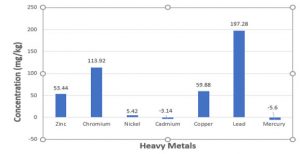
Figure 2: Concentration of heavy metals in Obajana (Obj)
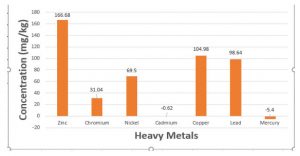
Physicochemical Analyses
Organic Matter: The Soil organic matter (SOM) of Ajaokuta (Ajao) and Obajana (Obj) was gotten to be 1.47% and 1.85% respectively. Soil organic matter (SOM) is associated with improved soil structure, to improve soil or root aeration. A typical agricultural soil has 1 – 6% organic matter by weight. A fertile and healthy soil is the basis for healthy plants, animals and humans. Organic matter helps to protect certain nutrients in the soil. The percentage of the organic matter of the soil samples worked on is shown in table 2. Since the two soil samples have Organic Matter value to be within the range of a typical agricultural soil, it is then good for agricultural activities.
Table 2. Results of Soil Organic Matter percentage of Samples Ajaokuta (Ajao) and Obajana (Obj)

Soil pH: Soil pH, the major factors that influence the behavior of heavy metals in soil within the soil matrix was determined. The pH of Ajaokuta (Ajao) and Obajana (Obj) soil sample were 2.670 and 6.096 respectively which indicates that the soil samples from the location were acidic. The results of this characterization are presented in table 4.3 below:
Table 4.3: Results of Soil pH in Ajaokuta (Ajao) and Obajana (Obj) Samples
| Parameter | Ajaokuta (Ajao) | Obajana (Obj) |
| pH | 2.670 | 6.096 |
Figure 3: Soil pH of Ajaokuta (Ajao) and Obajana (Obj) respectively
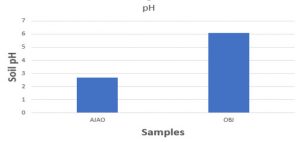
Soil Electrical Conductivity (µS/cm): Soil electrical conductivity is the amount of salts in soil (salinity of soil). It is an important indicator of soil health. The electrical conductivity of the two samples, Ajaokuta (Ajao) and Obajana (Obj) are given in the table below;
Table 4. Results of Soil Conductivity (µS/cm) for Ajaokuta (Ajao) and Obajana (Obj) Samples
| Parameter | Ajaokuta (Ajao) | Obajana (Obj) |
| Conductivity (µS/cm) | 184.5 | 320.4 |
Figure 4.4: Electrical conductivity in Ajaokuta (Ajao) and Obajana (Obj) respectively.
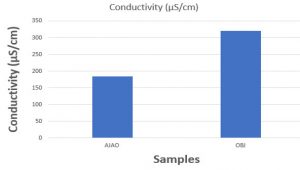
The permissible limits by World Health Organization (WHO), Canadian Councils of Ministers of Environment (CCME), and United State Environmental Protection Agency (USEPA) are given below in table 5.
Table 5. Permissible Limits for Heavy Metals in Soil
| Elements | WHO (1996)
(mg/kg) |
CCME (2007)
(mg/kg) |
USEPA (2002)
(mg/kg) |
| Zn | 50.00 | 500.00 | 1100.00 |
| Cr | 100.00 | 250.00 | 11.00 |
| Ni | 35.00 | 100.00 | 72.00 |
| Cd | 0.80 | 3.00 | 0.48 |
| Cu | 36.00 | 150.00 | 270.00 |
| Pb | 85.00 | 200.00 | 200.00 |
| Hg | – | 0.80 | 1.00 |
Figure 4.5: Permissible limits for the various heavy metals and their concentration in the soil.
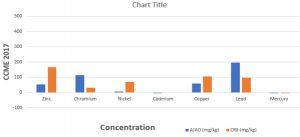
CONCLUSION
Heavy metal contamination in soil is very dangerous to human health because of agricultural activities that will be carried out on the soil. The results above shows that there were presence of heavy metals in the soil locations and they were found in high concentration (such as, Zinc-53.44mg/kg, Chromium-113.92mg/kg, Copper-59.88mg/kg, Lead-197.28mg/kg in sample Ajaokuta (Ajao) and Zinc-166.68mg/kg, Nickel-69.5mg/kg, Copper-104.98mg/kg, Lead-98.64mg/kg in sample Obajana (Obj) except for Mercury and Cadmium therefore posing potential risk for inhabitants. While the findings were geared towards providing baseline data on the current pollution states of the industrial areas, constant monitoring of the levels of contamination is deemed necessary, the industries in the areas should be cautioned and guarded against anthropogenic activities caused by industrial effluents, atmospheric deposition, erosion of geological matrix, domestic savage and mining wastes etc. would be suggested against soil contamination (18)
Recommendation
- Considering the conclusion of this assessment, there is need for constant monitoring of heavy metal concentrations in the industrial areas of Ajaokuta (Ajao) and Obajana (Obj).
- Concentrations of other heavy metals like Arsenic, Manganese, Aluminum, Cobalt, Tin and others should be assayed.
- The process of remediation could be carried out to get a healthy soil formation for every human activity.
REFERENCES
- Adedeji S. Asher1, Kakulu E. Samuel, Dauda S. Mary, Akannam O. Perpetua (2019). Heavy Metal Pollution in Soil Samples Obtained from some Communities around a Cement Factory in Obajana, Kogi State,Nigeria. J Environ Sci Public Health 2020; 4 (3): 161-174 DOI: 10.26502/jesph.9612009Corresponding Author: Dr. Adedeji Sunday Asher, Chemistry Unit, Mathematics Programme, National Mathematical Centre, P. M. B. 118, Abuja, Nigeria, Tel: +2348033624460; E-mail: sun05ade@gmail.com.
- Adams, W., Kimerle, R, and Barnett, J. J (2010). Sediment quality and aquatic life assessment. Environ. Sci. Technol, 26, 1864-1875
- Demková L., Jezný T., Bobuľská L. (2017). Assessment of soil heavy metal pollution in a former mining area – before and after the end of mining activities. Soil & Water Res., 12: 229-236 Doi: 10.17221/107/2016-SWR.
- Dundar M.S., Altundag H., Eyupoglu V., Keskin C.S., Tutunoglu C. (2012). Determination of heavy metals in lower Sakarya river sediments using a BCR sequential extraction procedure. Environ. Monit. Assess.33.15.
- Emurotu J. E. and Onianwa P. C. (2015). Bioaccumulation of heavy metals in soil and selected food crops cultivated in Kogi State, north central Nigeria Environ Syst Res 6:21 DOI 10.1186/s40068-017-00981.
- Fernandez E., Jimenez R., Lallena A.M., Aguilar J. (2015). Evaluation of the BCR sequential extraction procedure applied for two unpolluted Spanish soils. Environ. Pollut.131.355.
- Flora SJS, Saxena G, Gautam P, Kaur P, Gill KD. (2013). Lead induced oxidative stress and alterations in biogenic amines in different rat brain regions and their response to combined administration of DMSA and MiADMSA. Chem Biol Interac.170:209–220.
- Gabby, PN. (2011) Lead. In Mineral Commodity Summaries. Reston, VA: U.S. Geological Survey; http://minerals.usgs.gov/minerals/pubs/commodity/lead/.
- Godwill Azeh Engwa, Paschaline Udoka Ferdinand, Friday Nweke Nwalo and Marian N. Unachukwu (2019). Mechanism and Health Effects of Heavy Metal Toxicity in Humans DOI:http://dx.doi.org/10.5772/intechopen.82511
- U. Chibuike1 and S. C. Obiora (2014). Heavy Metal Polluted Soils: Effect on Plants and Bioremediation Methods. Hindawi Publishing Corporation. Applied and Environmental Soil Science, Volume 2014, Article ID 752708, 12 pages http://dx.doi.org/10.1155/2014/752708.
- He ZL, Yang XE, Stoffella PJ. (2013). Trace elements in agroecosystems and impacts on the environment. J Trace Elem Med Biol.19(2–3):125–140. [PubMed: 16325528].
- Hutton, M., and Symon, C. (2010). The Quantities of Cadmium, Lead, Mercury and arsenic entering the UK. Environment from human activities. Science of the Total Environment, 57, 129-150.
- INECAR (2010). Contaminants in the Mississippi River, U.S Geological Survey Circular 1133, Virginia, U.S.A.
- Jacobs D.E, Clickner R.P, Zhou J.Y, (2011). The prevalence of lead-based paint hazards in U.S. housing. Environ Health Perspect.110: A599–A606. [PubMed: 12361941].
- Keshavarzi, B., Mokhtarzadeh., Moore, F., RastegariMehr, M., Lahijanzaded, A., Rostami, S., et al. (2015). Heavy metal and Polycyclic Aromatic Hydrocarbons in Surface Sediments of Karoon River, Khuzestan Province, Iran. Environ. Sci. Pollut. Res., 22, 19077-19092.
- Mustafa Ertan Akün (2020). Heavy Metal Contamination and Remediation of Water and Soil with Case Studies From Cyprus DOI: http://dx.doi.org/10.5772/intechopen.90060 Intech open.
- Narjala Rama Jyothi (2020). Heavy Metal Sources and Their Effects on Human Health DOI:http://dx.doi.org/10.5772/intechopen.95370.
- Ofor, H.O. and Ojiaku, E.N. (2019). Phytochemical Analyses of River Water and Determination of Concentrations of Selected Heavy Metals in Africa Giant Catfish (Heterobranchus longifilis) obtained from Okpoko area, Ogbaru L.G.A., Anambra State, Nigeria. ANACHEM Journal., 9(1). 1769-1774.
- Ofor, H.O. and Ojiaku, E.N. (2017). Phytochemical Analyses of River Water and Determination of Concentrations of Selected Heavy Metals in Upside Down Catfish (Synodonotis membraucoeus) obtained from the river. COOU Journal of physical sciences, 1(2). 122-128.
- Ofor, H.O. and Ojiaku, E.N. (2019). Phytochemical Analyses of River Water and Determination of Concentrations of Selected Heavy Metals in channel catfish (Ictalurus punctatus) and physicochemical analyses of river water. COOU Journal of physical science, 1(2). 115-121.
- Olayinka, Oo; Akande, Oo; Bamgbose, K; Adetunji, Mt J. (2017). Physicochemical Characteristics and Heavy Metal Levels in Soil Samples obtained from Selected Anthropogenic Sites in Abeokuta, Nigeria. Appl. Sci. Environ. Manage. Vol. 21 (5) 883-891 https://dx.doi.org/10.4314/jasem.v21i5.14.
- Ogundele DT, Adio AA, Oludele OE (2015). Heavy Metal Concentrations in Plants and Soil along Heavy Traffc Roads in North Central Nigeria. J Environ Anal Toxicol 5: 334. doi:10.4172/2161-0525.1000334.
- Osakwe, Stephen Anapuwa; Okolie, Lucky Precious (2015). Physicochemical Characteristics and Heavy Metals Contents in Soils and Cassava Plants from Farmlands along A Major Highway in Delta State, Nigeria. J. Appl. Sci. Environ. Manage.
- Rashmi Verma and Pratima Dwivedi (2017). Heavy metal water pollution- A case study Recent Research in Science and Technology 2013, 5(5): 98-99 ISSN: 2076-5061 Available Online: http://recent-science.com.
- Ruqia Nazir1, Muslim Khan2, Muhammad Masab1, Hameed Ur Rehman1, Naveed Ur Rauf1, Surrya Shahab1, Nosheen Ameer1, Muhammad Sajed1, Mohib Ullah1, Muhammad Rafeeq1, Zeenat Shaheen1(2015). Accumulation of Heavy Metals (Ni, Cu, Cd, Cr, Pb, Zn, Fe) in the soil, water and plants and analysis of physio-chemical parameters of soil and water Collected from Tanda Dam kohat. Vol. 7(3), 2015, 89-97.
- Salomons, W., and Stigliani, W.B (2011). Biogeodynamics of Pollutants in Soils and Sediments. Berlin, Germany: springer.
- Sakagami KI, Eamada R, Kurobe T (2012). Heavy metal contents in dust fall and soil of the National Park for Nature Study in Tokoyo. Mitteeilungen der Deutschen Bodenkundlichen Gessellscaft., 33: 59-66.
- Silva A.L.O., Barrocas P.R.G., Jacob S.C., Moreira J.C. (2014). Dietary intake and health effects of selected toxic elements. Brazilian Journal of Plant Physiology, 17: 79–93.
- Turer D, Maynard J.B., (2010). Heavy metal contamination in highway soils. Comparison of Corpus Christi, TX and Cincinnati, OH shows organic matter is key to mobility. Clean Technology and Environmental Policy, 4: 235–245.
- Vhahangwele, M., and Khathutshelo, L. M (2018). Environmental contamination by heavy metals. London, United Kingdom.
- Ward L.N., Brooks R.R., Roberts E. (2012). Heavy-metal pollution from automotive emissions and its effect on roadside soils and pasture species in New Zealand. Environ. Sci.Technol.(9), 917.
- Wodaje Addis and Alemayehu Abebaw (2017). Determination of heavy metal concentration in soils used for cultivation of Alliumsativum L. (garlic) in East Gojjam Zone, Amhara Region, Ethiopia, Cogent Chemistry, 3:1, 1419422, DOI: 10.1080/23312009.2017.1419422To link to this article: https://doi.org/10.1080/23312009.2017.1419422.


